I am new to Nihinto Club and have minimal knowledge of and experience with Japanese swords but am trying to become more educated and need some help with a WW2 Japanese sword that I recently acquired. It apparently was inherited from the previous owners grandfather who brought the sword back from Japan at the end of WW2. Other than that, she had no other knowledge or information regarding the sword. The nakago is signed but I am not yet experienced at kanji translation. Because of the presence of a "star" stamp, I am led to believe that it was produced by a Rikugun Jumei Tosho smith but I do not know which. I've only been able to partially translate that it was likely made during the Showa Period (August of 1944??). As I mentioned, I am very new at this and may be completely wrong. Any assistance with the translation or any other information on the sword is greatly appreciated. If additional information detailed photos of each kanji are needed, please let me know. Thank you. Rob


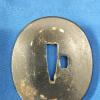
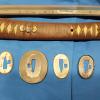
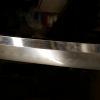
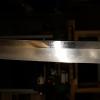

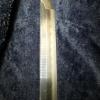

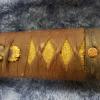

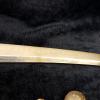
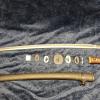
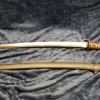

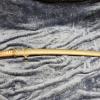
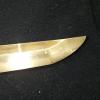
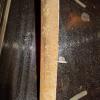
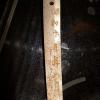

Zuiho
Blind luck finding it, on a list of showa era smiths signatures there's one that matches. "http://www.japaneseswordindex.com/oshigata/zuiho.jpg"
So the signature would be Zuiho tsuku(ru) kore, or "Zuiho made this". Not so sure on the date, its hard to see in the photo, but I'll take a guess at Showa, 17th year, eighth month? Could be totally wrong on the date, but the name is a definite match.
Showa 19
The date is Showa 19, 8th month (August 1944).
With the "star stamp", it is probably better quality than almost any other blade made in 1944, and certainly more rare.
Pete
different mei?
BTW, the first kanji doesn't look much like "ZUI" at all.
But the rest is very close to that Zuiho example, so it's likely the same guy, signing with a slightly different name.
The first kanji resembles "FUSA", and note that Zuiho's other common name was "Shigefusa".
If so, the pronunciation would NOT be "FUSAHOu", because that would be an awkward mix of onyomi and kunyomi readings. "Fusamine" would be more likely. But I could be wrong about the "Fusa".
Pete
Thank you so much to both
Thank you so much to both saipan59 and looper for the quick response and provided info. I honestly have no idea of value on this sword. The woman who gave it to me did so after her and I finished a lengthy conversation on each of our connections to Japan and grandfather's serving in WW2. She basically gave it to me for $50.00. I told her that I felt it was worth much more but she insisted that I have it and wanted it to go to someone who would value it as art rather than $$. Any ideas on ballpark value? She is an amazing person and I would like to compensate her more appropriately.
Not my best bit of
Not my best bit of translating, in my defense I was just in from the pub! I can see now that Pete is quite right, not the same first kanji. As for what it's worth, that would depend on condition. If you post photos of the blade and koshirae it might be possible to give you an idea of it's market value. Sounds to me though that she gave it to you for what it was worth to her, and as you said she wanted it to go to someone who would value it for what it is, not what it would cost.
value
A general statement on value:
At a minimum, the value is a 3-digit number.
If the condition is good enough, it would be a 4-digit number.
Pete
Thanks guys. I wil take some
Thanks guys. I wil take some pics of the blade and Koshirae and post within the next few days. I would like to safely clean the blade prior to doing so however. Can anyone recommend a quality kit to use? I've seen some on Amazon and eBay between $10-$15(US) but don't know if they contain genuine choji oil and uko or if just a cheap substitute that may be unsafe to use.
Sword care
I'm guessing you're in the U.S. I had a quick look at a few websites and found this "http://www.samuraisword.com/kits/basic/index.htm". Not cheap, but probably a good one. You can find a guide to sword care at "http://www.nbthk.com/".
care advice
Some thoughts on sword care:
The most important thing is going to be your "technique", more so than your materials.
Don't use abrasives or cleaning chemicals of any kind (but note that uchiko is technically an abrasive (like talc)). Don't remove rust. Don't touch the main part of the blade with bare hands.
"Genuine choji oil" is not really a thing. What is being sold is almost certainly some other type of oil, with enough choji added to make it smell like cloves. I believe this is true in Japan also.
Given that we're talking about a WWII blade, I would use a GOOD quality gun oil. If you have doubts about this approach, get a common nail (soft iron), polish it with steel wool, apply gun oil, let it sit for a few days, then see if there is discoloration, or if it has become "sticky", etc. Do NOT use motor oil, or cheap generic oil. Use the stuff that firearms collectors use on their very valuable antique guns, which are also made of carbon steel...
Use only a little bit of oil. A few drops is enough for an entire blade. Do not oil the nakago (tang), or anything other than the main part of the blade.
[Side note: There are some modern gun lubes that will have things like "non-toxic", "natural", etc. marked on the bottle. These are typically canola oil - so you're paying a lot for glorified Crisco. Of course, in the old days real choji oil was also a vegetable oil. But I recommend an appropriate modern synthetic.]
For cleaning with uchiko, the "official" thing is special and expensive Japanese paper. Instead, go to a fabric store and buy some plain, white, 100% cotton flannel. Cut it into 2" squares, and you're good to go...
If the blade is in excellent condition, do NOT store it in the original saya (scabbard). There will be dirt, dust, old oil, etc., inside it.
If the blade were in "fresh polish", the maintenance and handling procedures need to be more rigid.
Pete
Thanks Pete for the very
Thanks Pete for the very helpful information and instruction on cleaning and oiling the blade. I was able to find and purchase a quality cleaning kit and it is being shipped from Japan (thanks Looper for the point in the right direction on that!). Since it will be a bit of time until I receive delivery of the kit, I'll make a trip to my local fabric store and gun shop next week. Online I was able to locate a gun shop in the next town over to me that specializes in flint locks in addition to very high end modern firearms as well so I'm sure that they'll have some very good quality oil to use.
Pete, you mentioned if the blade is in excellent condition not to store the blade in the scabbard. I know that typically a high quality blade in excellent condition can be stored in a "storage saya" but would you suggest something else? I'm not saying that this blade is in "excellent" condition but the blade appears to have no cracks and chip free with what I hope is only light oxidation in a few areas. The Hamon is clear and I hope that after a good cleaning the blade could be considered to be in very good shape. Being that I'm new to the world of Japanese sword collecting and this is my first sword, my view of quality and condition may be way off.
Once I have a chance to properly clean the blade, I'll take more pics of the entire blade and Koshirae to include pics under magnification and will post soon.
Thank you to all who have posted their feedback. It helps immensely.
saya options
A "storage saya" is called a "shirasaya" (lit. "white scabbard").
That would be the ideal for a valuable blade in good polish.
But for just safe storage, wrapping in acid-free paper is OK.
Or use the white cotton flannel.
Or, if you happen to be good at woodworking, you can make a storage box. Use the poplar wood sold at HW stores (used for furniture-making). Poplar is very close to the Japanese "honoki" wood used to make a saya in Japan. A storage box (or saya, for that matter) should be designed such that the ONLY place that makes contact is at the habaki (metal collar on the blade) and the back surface of the kissaki (tip) - that is, the last 1/2" or so of the "mune" (the back of the blade). Nothing should touch the main surfaces of the blade, because moisture and dirt will eventually cause a rust spot. If you look at a blade with a traditional polish, you'll see that the mune near the tip has a more matte finish. I think this is because that area is intended to be in contact with the wood.
Controlling the temperature and humidity is a good idea. Temperature changes cause condensation, etc. A properly-fitting saya (or box) helps, by keeping fresh air and moisture from getting at the blade.
FYI, A blade that has NOT been polished recently tends to be somewhat "stable" - there is a microscopic oxidation layer on the steel that protects it. But moisture, or the salts/oils from a fingerprint, break down the oxidation layer and cause fresh rust to start. If not stopped, it keeps getting worse.
Pete
or
I should add that if your blade has already spent decades in the saya, and there is no sign of modern rust, it MAY be fine to continue...
Also, a traditionally-made saya has a seam running lengthwise, and it may be designed to be split open for cleaning. I'm sure there's a right way to do that, but I don't know the details...
Trivia: A saya is made with ONLY hand saws and chisels and knives - sandpaper (or similar) is never used, because bits of grit could be left behind in the wood, causing a huge scratch.
Pete
New photos
I've finally completed cleaning the Shin-Gunto and have added new photos to the previous mei photos. After/while cleaning, I did notice a small chip at the tip of the Kissaki. Also, the mekugi are missing. The photos did not turn out as good as I had hoped and the lighting didn't help. I am curious of your thoughts on the condition and look forward to any comments.
looks good
Very nice overall. The missing mekugi is not a big deal - you can make one from a bamboo chopstick.
Got any pictures of the tsuba?
Pete
Tsuba pic
Sorry it took me a while to post the tsuba pic. I've been out of town on work for a few days. Per your suggestion Pete, I'm looking in to making a storage box or maybe at some point in the future (and after a lot of practice) maybe a shirasaya. I've dabbled with woodworking here and there over the years and already have poplar down in the basement. Also, I've been trying to find more info on Zuiho. I found that his family name was Kojima (real name Kojima Kameta) and that he went by Genbusai and then later as Shigefusa. I know that there may not be much info out there on him but if anyone has more information I'd really appreciate learning more. Thanks again.
Rob